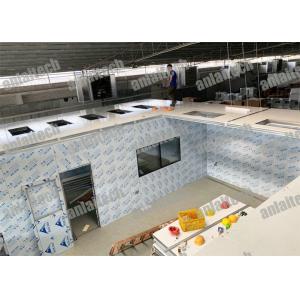Modular ISO8 SUSQ195 Laboratory Cleanroom HEPA Filter 3843m3/H
Add to Cart
ISO 5-8 Modular Laboratory Clean Room / Cleanroom
A clean room is an enclosed area employing control over the particulate matter in the air with temperature, humidity and pressure control as required. To meet the requirements of a 'clean room' as defined by generally accepted standards, all clean rooms must not exceed a particulate count as specified in the air cleanliness class. The IS Med Specialties (ISM) clean room is regulated to the Class 100,000 standard; meaning that the particle count inside does not exceed 100,000 particles per cubic foot. To provide a little background, the U.S. Federal Government established standards that were applied throughout the world (such as Class 100,000). More recently, global clean room classifications and standards have been adopted by the International Standards Organization (ISO). The Class 100,000 clean room is equivalent to an ISO 8 clean room standard.
A clean room is built in a contained space and controls environmental parameters such as humidity, pressure and temperature. The key component is the High Efficiency Particulate Air (HEPA) filter that is used to trap particles that are as small as 0.3 micron in size. HEPA filters are essential in providing contamination control.
HEPA Air Filtration in Modular Cleanrooms
Because the contained space of a modular clean room is intended to
reduce particulate contamination, HEPA air filters are key to their
performance. All the air delivered into a modular clean room passes
through one or more High Efficiency Particulate Air filters, which
trap any particles larger than 0.3 microns in size. For
applications that require even greater cleanliness, ULPA (Ultra Low
Particulate Air) filters that trap particles as small as 0.12
microns can be used.
Filtered air is supplied from overhead and, in most cases, passes out of the cleanroom via low wall vents. Single pass modular cleanrooms simply pull air in through the ceiling and exhaust it out; recirculating modular cleanrooms recycle the exhaust air back into the filter in a process of continuous circulation. Each design provides different benefits, and can impact other environmental parameters, such as temperature, humidity, and pressure.
What rules do employees have to follow to avoid contamination?
Employees are provided with gloves, gowns, masks and booties.
Employees are not to wear perfumes, make up, lotions or aerosols
inside of the clean room. No personal items are to be carried into
the clean room. No one who is physically ill may enter the clean
room. In addition, there are personal actions that are prohibited
in the clean room including scratching head, combing hair, removing
garments prior to gowning area, fast motions, improper changing of
gloves, etc. Management of housekeeping is an essential part of the
overall cleanliness of any clean room. There are required
procedures for each class of clean room. For example, a Class 100
clean room requires the wiping down of walls and trim to be
preformed on a weekly basis. A Class 1000 clean room may have more
rigorous housekeeping regulations such as, using a DI cleaner
(De-ionized water) and an approved wet mop to clean up to 2 times
per shift.



